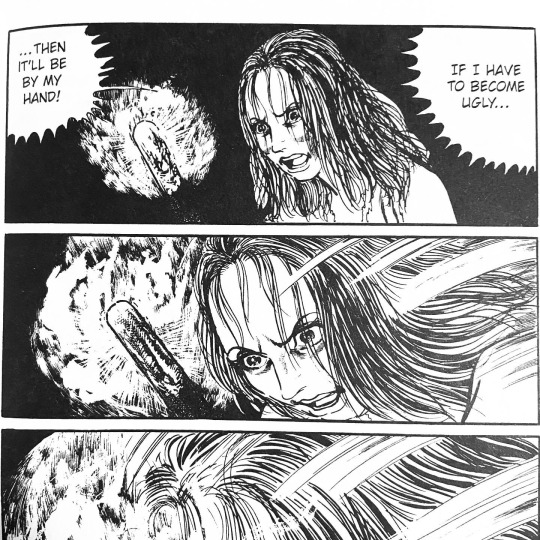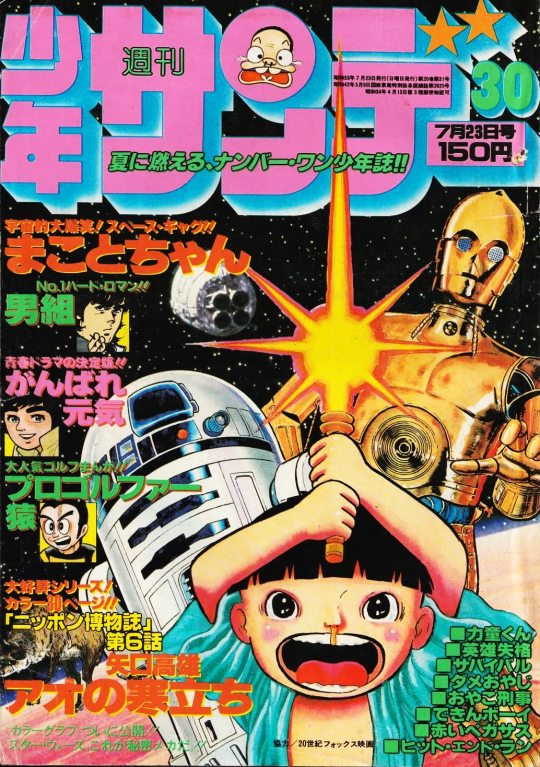#umezz
Text

Kazuo Umezu's ultraman comic
13 notes
·
View notes
Text










Always a barrel of laughs on the Orochi show. (Orochi, by Kazuo Umezz; 1969.)
#kazuo umezz#kazuo umezu#umezu kazuo#umezz#kazz#horror manga#retro manga#classic manga#comics out of context#bedtime comics
32 notes
·
View notes
Text




So many textures!!! I love that he brought in the block coloring w the door herr and w the little girl's shock. I love that he didnt keep the blocks to just the robot. Also love that he puts so much into the scenery as far as texture and detail goes, in some of the more zoomed out shots (not necessarily these ones) its like a complete flat balance to where characters are with the background and not in front of it. I like that altho some nerds might say that makes it harder to look at. Anyway. Look at these textured shadows/darks. Wtf. No one asks u to do that in comics. Flat black. But i love these. Kazuo umezu gush #2 over
1 note
·
View note
Text

hereditary but by kazuo umezz
2K notes
·
View notes
Text




#cat-eyed boy#kazuo umezz#my art#i figured i'd just put all of these in one post since i can't imagine the cat-eyed boy audience is so big#the second one is jack kirby styled. it's fun to do that to old manga characters yknow
78 notes
·
View notes
Text
Social Commentary, Horror Manga and the Left: From Ero-Guro to Junji Ito

Content Warning: gore and body horror
Horror manga has always had ties with revolutionary politics. Its beginnings, in fact, start with a Marxist-oriented magazine in the 1960s. Garo, an early gekiga magazine for avant-garde art, was one of the most important magazines for the development of horror manga. Its publication lasted almost 40 years (starting in 1964 and ending in 2002) and the earliest works of horror manga can be found in its pages, as well as a career starting point for the majority of early horror manga artists. Aside from this, horror manga has ties to the ero guro nansensu movement of the 1920s (arguably earlier if certain woodblock prints are considered “ero guro”), which has a clear revolutionary bent. Horror manga today may be more detached from this history, but there are still traces of this revolutionary ethos in modern works.
Garo, The Legend of Kamui, and Burakumin
Garo was an alternative magazine published in kashi-hon stores during the 1960s which became the center of the Japanese counterculture movement. At the time, manga’s main distribution channels were weekly magazines made to correspond to TV series, such as Astro Boy or Speed Racer. Because these magazines’ main demographic was children, stories catering to mature audiences had to find somewhere else to be published. This is where the kashi-hon’ya industry comes in; kashi-hon refers to a for-profit rental service for books (similar to the old video rental stores in the U.S.). These stores allowed for the publication of more mature stories and the rise of gekiga, a form of graphic novel that dealt with more explicit themes.
Garo was the most popular magazine distributed within this network. At its peak in 1970, 80,000 copies of the magazine were published. Its main artist, Shirato Sanpei, had notoriety because one of his stories, Ninja Bugeicho, received a film adaptation in 1967. Shirato was a Marxist known for his social commentary; Ninja Bugeicho itself is a story about a left-wing uprising among the peasant class.
Read it at Anime Feminist!
#horror manga#kazuo umezu#kazuo umezz#junji ito#gegege no kitaro#gyo#the drifting classroom#kamui-den#the legend of kamui#articles#horror#gekiga
35 notes
·
View notes
Text

Venus in the Blind Spot - Master Umezz and Me | Junji Ito
25 notes
·
View notes
Photo

Shonen Sunday magazine, a July issue in 1978 featuring Kazuo Umezz’s Makoto-chan hyping up the new hit movie Star Wars!
#kazuo umezu#Kazuo Umezz#Makoto-chan#70s manga#Shonen Sunday#manga cover#Star Wars#may the 4th be with you
89 notes
·
View notes
Text
Summerween Day 6: Horror and Thriller Manga
This is part of the masterpost of horror recommendations for Summerween 2024. See the masterpost here.
Manga is great at capturing expressions and showing us the scope of something strange, uncomfortable, or weird.

Berserk | Kentaro Miura: As a B&N employee stated—man is too angry to die. Come for Miura’s fantastically horrifying art, stay for Guts and Griffith.
Monster | Naoki Urasawa: This is in the thriller category, fairly grounded and for a 9 volume (in the Perfect edition) it keeps the horror and thrills GOING.
Uzumaki & Gyo | Junji Ito: Ito's art is fantastic, and is highlighted in both these stories.
Tokyo Ghoul | Sui Ishida: This series has a lot of ups and downs but there’s some fantastically nasty cannibalism throughout.
The Drifting Classroom & Orochi | Kazuo Umezz: Honestly, classics. Children transported to a hostile nightmare world, fantastic. The art isn't what we could consider horrific (comparing to folks like Miura or Ito) but that makes the horror even creepier.
Jujutsu Kaisen | Gege Akutami: There's a lot of nastiness in this shonen story. Ghosts, ghouls, weird high school.
#berserk#kentaro miura#monster#naoki urasawa#uzumaki#gyo#junji ito#tokyo ghoul#sui ishida#the drifting classroom#kazuo umezz#jujutsu kaisen#gege akutami#bookblr#reading recommendations#horror books
8 notes
·
View notes
Text










One of those mornings. (Orochi, by Kazuo Umezz; 1969.)
#kazuo umezz#kazuo umezu#umezu kazuo#umezz#kazz#horror manga#retro manga#classic manga#manga#body horror#comics out of context#bedtime comics
4 notes
·
View notes
Text

1 note
·
View note
Text
New Manga by Umezz!

8 notes
·
View notes
Text


#drifting classroom#kazuo umezu#kazuo umezz#viz#viz media#horror#horror manga#horror comic#horror comics#manga#poll
9 notes
·
View notes
Photo

Orochi (おろち), Kazuo Umezz
25 notes
·
View notes

